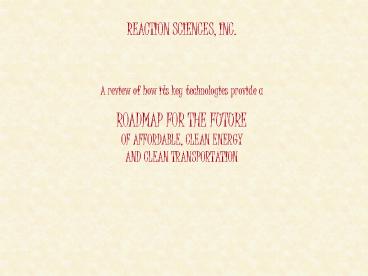REACTION SCIENCES, INC' - PowerPoint PPT Presentation
1 / 14
Title:
REACTION SCIENCES, INC'
Description:
already cheaper than gasoline, using domestic resources. ... (STIRLING ENGINE) UREA. DECOM- POSITION. UREA. DECOM- POSITION. UREA. UREA. UREA. NH3. H2. NH3 ... – PowerPoint PPT presentation
Number of Views:32
Avg rating:3.0/5.0
Title: REACTION SCIENCES, INC'
1
REACTION SCIENCES, INC. A review of how its
key technologies provide a ROADMAP FOR THE
FUTURE OF AFFORDABLE, CLEAN ENERGY AND CLEAN
TRANSPORTATION
2
Reaction Sciences, Inc.
Key Energy Technologies
- SUMMARY
- V- Process
- Thermochemical Hydrogen process converts
medium-grade heat to hydrogen. - Solar energy, waste heat from power plants,
and waste gases can all be used - as the energy source.
- Makes hydrogen at very high efficiency and low
cost. - Integrated cycle with fuel cell can produce
hydrogen from sunlight at unprecedented high
efficiency. - Urea as energy storage medium and as
transportation fuel - Safe, non-toxic, good energy density.
- Is already produced in very large quantities
using natural gas as a feedstock - already cheaper than gasoline, using domestic
resources. - By integrating with V-Process, can be made
inexpensively using solar energy - and power plant exhaust gases.
- Vanadium or Iron Redox Cell
- Store electrical energy inexpensively with high
efficiency or - Inexpensively generate hydrogen from
electricity at high efficiency. - Can be used on a commercial scale for load
leveling or PV energy storage. - Can be used on a utility scale for load
leveling of the grid.
3
V-Process Thermochemical Hydrogen Production
Convert any source of heat (approx. 400 C or
better) to hydrogen
4
V-Process Can use Concentrating Solar Thermal
technology even already-commercial trough
technology (shown) to convert sunlight directly
into hydrogen. Hydrogen can be produced at low
cost, and at very high efficiency.
CONCENTRATING SOLAR THERMAL TECHNOLOGY
THERMAL ENERGY
HYDROGEN
OXYGEN
5
V-Process Can also convert the energy from
combustible process waste gases an abundant,
cheap energy source - into hydrogen. Hydrogen
can be produced at very low cost, and at very
high efficiency.
COMBUSTIBLE PROCESS WASTE GASES
THERMAL ENERGY
HYDROGEN
OXYGEN
6
V-Process Can also utilize landfill gas.
LANDFILL GAS
THERMAL ENERGY
HYDROGEN
OXYGEN
7
V-Process Biogas.
ANAEROBIC DIGESTER GAS
THERMAL ENERGY
HYDROGEN
OXYGEN
8
V-Process Or the waste heat from power plants
(an extremely abundant resource) to make cheap
hydrogen.
POWER PLANT WASTE HEAT
THERMAL ENERGY
HYDROGEN
OXYGEN
9
V-Process Can be integrated with
high-temperature fuel cells, including thermal
integration, to convert sunlight to electricity
at unprecedented efficiencies.
SOLID OXIDE FUEL CELL
CONCENTRATING SOLAR THERMAL TECHNOLOGY
RECYCLED THERMAL ENERGY / STEAM
THERMAL ENERGY
HYDROGEN
ELECTRICITY
50 EFFICIENCY
OXYGEN
10
- Urea as a Transportation Fuel
- Urea as a fuel
- Has about the same specific energy as
bituminous coal - Is fairly energy dense (about _ that of
liquified hydrogen) - Is not flammable or explosive
- Is non-toxic
- Leaves no residue
- Urea is currently made in large quantities, at
or below the current cost of gasoline, from
natural gas an abundant, relatively clean,
domestic energy resource. - Urea can be made at low cost from solar energy
and other super-abundant resources, including the
exhaust gases from power plants. - Urea is a zero-emission fuel, including net zero
greenhouse gas emissions when renewably-produced
hydrogen from the V-Process is used. - When using the exhaust gases from power plants
as a feedstock, urea fuel stockpiles are
sequestering carbon (until used up as fuel).
11
UREA PRODUCTION CURRENT ART
N2
UREA SYNTHESIS
AMMONIA SYNTHESIS
STEAM REFORMER
NATURAL GAS
NH3
UREA
H2
CO2
12
Urea as a Transportation Fuel There are several
promising technology paths for using urea as a
transportation fuel.
SHAFT POWER OR ELECTRICITY
NH3 REFORMER
PEM FUEL CELL
UREA DECOM- POSITION
UREA
NH3
H2
UREA FUEL
SHAFT POWER OR ELECTRICITY
INT. COMB. ENGINE
UREA DECOM- POSITION
UREA
NH3
- Maximum Hydrogen
- Content is 7.69
- Hydrogen Cost 2/kg
SHAFT POWER OR ELECTRICITY
EXT. COMB. ENG. (STIRLING ENGINE)
UREA
13
Integration of these technologies creates the
real potential for an affordable and practical
energy and transportation system in which
sunlight and other super-abundant resources are
used to produce clean transportation fuel and
energy services.
CONC. SOLAR THERMAL TECHN.
THERMAL ENERGY
UREA SYNTHESIS
HYDROGEN
UREA
OXYGEN
POWER PLANT EXHAUST (CO2 N2)
GAS TURBINE POWER PLANT
RECYCLED THERMAL ENERGY
ELECTRICITY
NATURAL GAS
14
Reaction Sciences Redox Cell technology, using
either iron or vanadium, can provide a very
high-volume storage method for electric power
that can store solar energy or levelize loads,
even on the utility scale.































